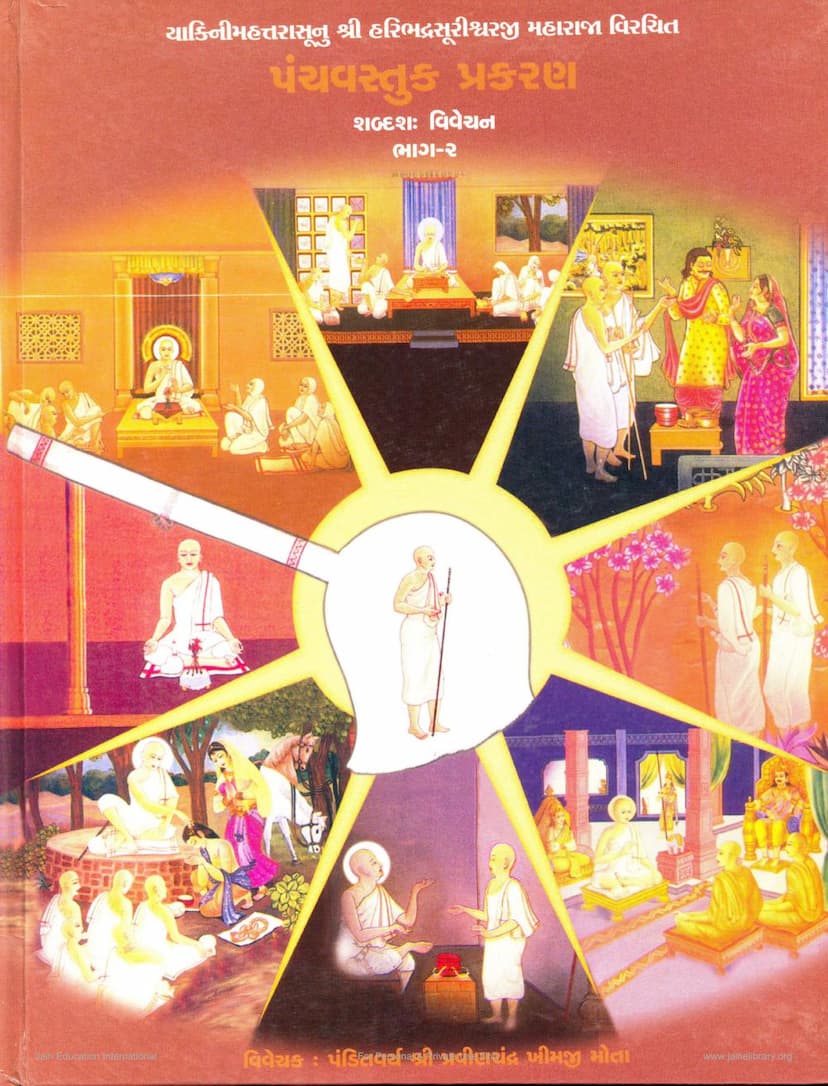Panchvastuk Prakaran Part 02
Added to library: September 2, 2025

Summary
Here's a comprehensive summary in English of the Jain text "Panchvastuk Prakaran Part 02," based on the provided pages:
Book Title: Panchvastuk Prakaran Part 02 (A Word-by-Word Commentary)
Author of Commentary: Pandit Shrimad Pravinchandra Khimji Mota
Original Author: Acharya Shrimad Haribhadrasurishwarji Maharaj (son of Yakshini Mahattara)
Publisher: Gitarth Ganga
Overview:
This book, "Panchvastuk Prakaran Part 02," is the second volume of a detailed word-by-word commentary on the original Jain text "Panchvastuk Prakaran" by the esteemed Acharya Haribhadrasurishwarji Maharaj. The commentary has been meticulously prepared by Pandit Pravinchandra Khimji Mota. The Gitarth Ganga Trust is the publisher, with the aim of disseminating the profound spiritual and philosophical truths embedded within Jain scriptures.
Content and Structure:
The original "Panchvastuk Prakaran" is a vast text of 1715 verses, dealing with five core principles or "vastus." This second part focuses specifically on the second principle, titled "Pratidin Kriya" (Daily Conduct/Practices). The text is structured around the teachings of Acharya Haribhadrasurishwarji, aiming to provide a clear and insightful explanation for seekers of Jain philosophy.
The "Pratidin Kriya Vastu" is presented through ten specific "dwaras" (gateways or sections), which are:
- Pratyupekshana Dwar (Inspection/Examination Gate): This section details the meticulous inspection required for monastic possessions.
- Pramanjana Dwar (Sweeping/Cleaning Gate): This covers the practices of cleaning the living space to avoid harming microscopic organisms.
- Bhiksha Dwar (Alms-Seeking Gate): This outlines the proper conduct for monks seeking alms.
- Irya Dwar (Movement/Conduct Gate): This focuses on the careful and mindful conduct while moving about.
- Alochana Dwar (Confession Gate): This describes the process of confessing faults and transgressions.
- Bhojan Dwar (Eating Gate): This section details the principles and practices associated with eating.
- Patra Dhāvan Dwar (Utensil Washing Gate): This covers the rituals and methods for washing utensils.
- Vichar Dwar (Excretion Gate): This addresses the proper conduct related to the evacuation of bodily waste.
- Sthanḍil Dwar (Placing/Ground Gate): This likely relates to the proper placement of items or the state of the ground.
- Aavashyakadi Dwar (Obligatory Rites Gate): This covers essential daily religious practices like Pratikraman (repentance ceremony).
Key Themes and Purpose:
- Meticulous Adherence to Rules: The commentary, by breaking down each word and concept, emphasizes the profound detail and strict adherence to the code of conduct prescribed for Jain monks. Every action, from inspecting possessions to eating, is imbued with spiritual significance and aims at minimizing harm to all forms of life and fostering spiritual growth.
- Spiritual Discipline: The text highlights the constant vigilance and self-awareness required in the monastic life. The "Pratidin Kriya" are not mere rituals but practices designed to purify the mind, control the senses, and progress towards liberation (moksha).
- Commentary's Contribution: Pandit Pravinchandra Mota's commentary is praised for its depth and clarity, making the original complex teachings accessible to both scholars and those less familiar with Sanskrit and Prakrit languages.
- Guidance for Sages and Seekers: The book serves as a vital guide for monks and nuns in their daily practices and for all Jain followers seeking to understand the practical application of Jain principles.
Specific Details from the Commentary (as seen in the pages):
- Pratyupekshana (Inspection): The commentary elaborates on the minute details of inspecting clothing and other possessions to ensure no living beings are harmed. The methods of folding, shaking, and examining are described.
- Pratikraman (Obligatory Rites): The importance of daily observances like Pratikraman is reinforced.
- Bhiksha (Alms-Seeking): The text delves into the nuances of alms-seeking, including the proper time, place, and conduct, as well as the ethical considerations involved.
- Alochana (Confession): The process of confessing faults and its spiritual significance are discussed.
- Bhojan (Eating): The principles of mindful and regulated eating, including the proper way to receive and consume food, are detailed.
- Vichar (Excretion): The proper procedures for attending to bodily needs are covered.
- Protection of Life (Ahimsa): A recurring theme is the utmost care taken to protect all living beings, from macroscopic to microscopic, in every action. This is demonstrated through detailed explanations of practices like pramārjana (sweeping) and pratyupekshana (inspection).
- Respect for Gurus and Scriptures: The commentary underscores the importance of following the teachings of the scriptures and the guidance of spiritual masters.
- The Purpose of Pratidin Kriya: The text explains that performing these daily actions correctly and with mindfulness ensures the success of one's monastic life and leads to the purification of the soul, ultimately paving the path to liberation.
Conclusion:
"Panchvastuk Prakaran Part 02" is a scholarly work that aims to illuminate the practical aspects of Jain monasticism through the lens of Acharya Haribhadrasurishwarji's original text. The detailed commentary by Pandit Pravinchandra Mota ensures that the profound wisdom and rigorous discipline inherent in Jain daily practices are understood and appreciated by a wider audience. The book is a testament to the commitment of the Gitarth Ganga Trust to preserving and propagating Jain spiritual heritage.